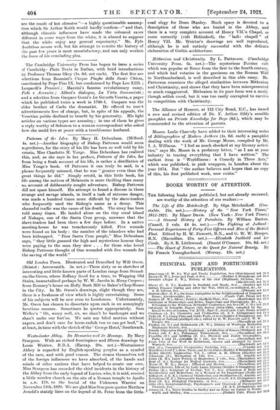Westminster Abbey. Its Memories and its Message. By Mary Sturgeon.
With an etched frontispiece and fifteen drawings by Louis Weirter, R.B.A. (Harrap. 20s. net.)—Westminster Abbey is regarded by English-speaking peoples as a symbol of the race, and with good reason. Tho stones themselves tell of the foreign influences we have absorbed, of the hands and minds of other nations that have helped to create our own. Miss Sturgeon has recorded the chief incidents in the history of the Abbey from the early legend of Lucius, who, it is said, erected a little wooden church on the site of a Roman temple to Apollo in A.D. 178, to the burial of the Unknown Warrior on November 11th, 1920. We are glad Miss Sturgeon quotes Matthew Arnold's stately lines on the legend of St. Peter from the little-
read elegy for Dean Stanley. Much space is devoted to a description of those who are buried in the Abbey, and there is a very complete account of Henry VII.'s Chapel, or more correctly (tide Holinshed), the " ladi3 chapel " of Henry VII. Mr. Weirter's drawings are well reproduced, although he is not entirely successful with the delicate elaboration of Gothic architecture.


































 Previous page
Previous page